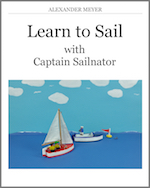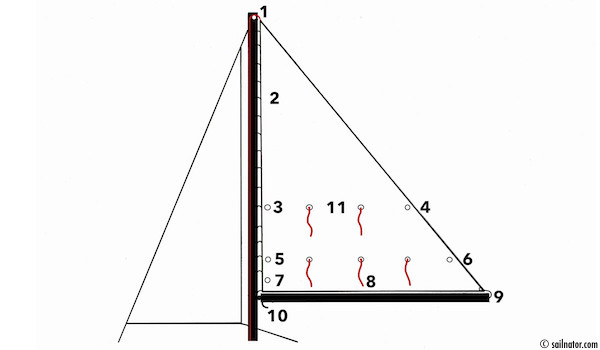In this chapter I explain reefing. That means we lower the sails and reduce the sail area. Then why do we reef and when? We reef when the wind gets too strong.
If we do not reef a dinghy in increasing wind speed we will get into the danger of capsizing. On keelboats the rig will be heavily affected. In extreme case the sails can rip or the boat will be dismasted. The stronger the wind the more difficult the boat and the sails are to handle. The sails otherwise generate weather helm, meaning that the bow tries to move windward without steering in that direction. We have to steer in the opposite direction, which is exhausting over time. The rudder is unnecessarily heavily affected and the boat might broach. That means the boat shoots up head into wind unintentionally, because the boat heels so much that the rudder has no effect anymore.
 This online sailing course has also been published as ebook and paperback. For more information click here!
This online sailing course has also been published as ebook and paperback. For more information click here!
You can download the Ebook for example at:
iTunes UK & iTunes US | iBooks for iPad and Mac
Amazon.com & Amazon.co.uk | Kindle-Edition
Google Play | for Android
The paperback is available for example at:
Amazon.com | Amazon.co.uk
Anyway when heeling heavily a lot of wind moves over the sails without any effect. To prevent capsizing with the dinghy we have to ease the mainsail. But that is not the proper trim for the sail and we can generate more power by shortening the sails. So we should think about reefing early enough. Ideally before we start sailing. A harbour is often more peaceful and protected. A walk to the quay bulkhead might tell us more about the wind conditions out on the water. Before we start sailing we should check the weather forecast. In some areas there are warning lights in case a storm comes up. Gale warnings should never be ignored. Before we sail in an unknown area we have to inform ourselves about the local weather conditions.
The principle of reefing is: When you first think about it or if you have any doubts: do it. Otherwise it might be too late. There are some different reefing systems for sailboats but the basic concept stays the same. In the case of the mainsail it mostly looks like figure 132. The jib can be reefed too by furling it for example. Or we can hoist a smaller one if we have one.
The way to reef the mainsail is as follows: The luff of the sail runs in a track in the mast or runs on sliders fastened onto the sail. The head of the sail is fixed to the halyard with a knot or a shackle. (closed metal hook) With the halyard we hoist and secure the mainsail. The clew is pulled back to the boom head by a line that is called outhaul. In strong winds the sail is trimmed flat, so the outhaul is hauled tightly then. In calm winds the outhaul has to be eased a bit. At the end of the outhaul there is a shackle or a snap hook to attach it to the clew. Sometimes it is only knotted.
Close to the gooseneck on the left and the right side in the front of the boom there often is a metal hook called tack horn. Above this hook in the sail there are grommets. (Metal rings with a hole in the middle.) They are called cringles. The first cringle above the tack horn is mostly the Cunningham cringle. The Cunningham is a line that runs through that cringle. It is used to pull down the luff of the mainsail to tighten it.
But for reefing the other cringles in the sail are important. Above the Cunningham cringle there are the first and sometimes the only reef points. (A horizontal row of grommets.) If the sail is already hoisted we have to release the main halyard. Then we pull the sail down till we reach the tack horn with the first reefing cringle, which is called tack cringle. We make a new tack by putting the tack horn into the tack cringle. That works well when sailing on a close-hauled, when heaving-to or ideally in the harbour before departure. If we want to reef in the dock and the sails are already hoisted the boat has to be head up to wind. But we can put the hook into the cringle before we hoist the sail too.
If the tack horn is placed in the tack cringle we can then release the outhaul from the leech. As I said before it is attached there through a shackle, a snap hook or it is knotted. We now put the outhaul into the last cringle (clew cringle) of the first row of reefing points close to the leech and haul it tight.
On some boats there is fixed a line at one side of the boom. It can be pulled through the first clew cringle and then be cleated on the other side of the boom. With this system the outhaul does not have to be released.

Figure 132: Terms: 1: Main halyard | 2: Sliders | 3: Second tack (reefing) cringle | 4: Second clew cringle | 5: First tack (reefing) cringle | 6: First clew cringle | 7: Cunningham cringle | 8: Earing (or marline) | 9: Outhaul | 10: Tack horn (metal hook) | 11: Reefing points (horizontal row of grommets)
Progress reefing: Release main halyard (1) | Secure first or second tack cringle (3/5) into tack horn (10) | Put outhaul (9) from clew into first or second clew cringle (4/6) at the leech and haul it | Haul main halyard (1) again | 5. Tie up the lowered sailcloth with the earings (8) that run through the middle reefing points (11)
Between the tack cringle and the clew cringle there are the middle reefing points. Through these grommets short ropes (called earings or marlines) run. On each side of the sail they are secured by a figure-eight knot so they cannot slide out. With these earings we can tie up the middle of the lowered part of the sail. That is not really necessary but it is better for our visibility and looks much nicer.
If the wind becomes stronger we can release the mainsheet by sailing on a close-hauled or by heaving-to again. We lower it down till the second tack cringle is reached. We put it into the tack horn. The outhaul has to be put into the second clew cringle and the lowered part of the sail can be tied up again.
If this is not enough and the boat is still heeling too much we should reef the jib. On some boats it can be furled, on others we have to hoist a smaller jib. If that is not possible it should be secured. That should be the point when we return to the dock. If the wind calms down in the meanwhile we can do the whole manoeuvre backwards by shaking out the reef.
In this chapter we learned in which situation we reduce our sail power and how we do it. We know now that it is better to reef timely and that we can shake it out every time as soon as the wind calms down again. But what happens if we do not reef soon enough? Our dinghy will probably capsize. I will explain all of this in the next chapter.
← Last chapter | Next chapter →
All chapters: Technical Terms | The theory behind sailing |Close-hauled | Beam reach | Broad reach | Sailing downwind | Tacking | Beating | Quick-turn | Sailing up head to wind | Man overboard | Jibing | Heaving-to | Leaving the dock | Berthing | Rules of the road 1 | Rules of the road 2 | Rules of the road 3 | Reefing | Capsizing